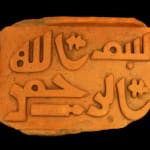Umayyad Wall Plaque with Kufic Text, 8th Century CE
Terracotta
18.25 x 12.5
PF.6186
The early history of Islam following the death of the Prophet Muhammad can be characterized by glorious wars and victories on the one hand and by jealousy, intrigue, and deceit...
The early history of Islam following the death of the Prophet Muhammad can be characterized by glorious wars and victories on the one hand and by jealousy, intrigue, and deceit on the other. When the Umayyad Dynasty ruled in splendor from their capital at Damascus, a terracotta plaque such as this one would have decorated the wall of a sacred mosque or splendid palace in a distant province. The rulers of the Umayyad Dynasty, beginning with the founder, Mu'awiyah, claimed a blood relationship with the Prophet via his sister, Umm Habibah, and his Abu-Sufyan, the leader of the Meccan Quraysh. As the Islam spread across North Africa and into Europe, political rivalry began to emerge between the Caliphs. These family feuds would culminate in 749 A.D. when the entire Umayyad clan was murdered, save for abd-al-Rahman, who fled to Spain and founded an independent Umayyad Caliphate there. In part, this division between opposing Muslim factions of Shi’ite and the Sunni continue to this day. Overall, the period of the Umayyad Dynasty can be characterized by a love of luxury. Great palaces were erected in the capital of Damascus and throughout the empire. This plaque, found in Afghanistan, reveals the great expanse of the Umayyad Dynasty and of Islam as well.
The plaque features and inscription in the angular Kufic style that can be translated as “in the name of the merciful god.” One can imagine such a work imbedded into the tiled mall of a mosque, reminding the visitor that they are entering holy space. More than a relic of a lost culture, this plaque is a testament to the faith and expanse of the early Islamic world.
The plaque features and inscription in the angular Kufic style that can be translated as “in the name of the merciful god.” One can imagine such a work imbedded into the tiled mall of a mosque, reminding the visitor that they are entering holy space. More than a relic of a lost culture, this plaque is a testament to the faith and expanse of the early Islamic world.



